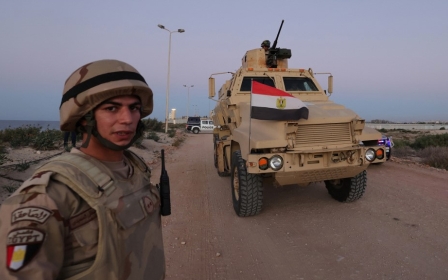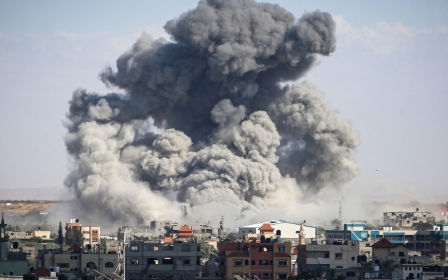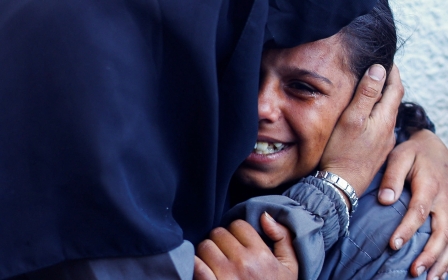Gaza: Where is Rafah - and why does it matter?

Rafah, the southernmost city in the Gaza Strip, is under siege and constant attacks, despite Israel declaring it a safe zone last year.
Before 7 October, the city, which spans just 64 km2, was already overpopulated and wracked by poverty and harsh living conditions due to the Israeli blockade, which began in 2007. Since then, Israel has driven Palestinians from northern and central Gaza towards the south: as a result, Rafah's population has grown fourfold to an estimated 1.5m people.
The people in Rafah are now living in a cramped, makeshift tent city. Many are Palestinian refugees who have already been displaced multiple times.
Israel's prime minister, Benjamin Netanyahu, has warned multiple times during the current war that Israel will launch a ground invasion despite international protestations. Aid groups and analysts have told Middle East Eye that it will create a humanitarian catastrophe, and could pave the way for the ethnic cleansing of Palestinians from Gaza into Egypt's Sinai.
It is but the latest fate to befall a city that has been swapped between ancient and medieval empires and dynasties over the centuries, including being cut in half in the early years of the 20th century by the British and Ottoman Empires.
Stay informed with MEE's newsletters
Sign up to get the latest alerts, insights and analysis, starting with Turkey Unpacked
Where is Rafah? What is its history?
Rafah is at the southern tip of the Gaza Strip and the only crossing between the enclave and Sinai, which is part of Egypt.
The city is more than 3,000 years old and emerged as an oasis. What is now modern Rafah first appeared in ancient Egyptian inscriptions dating back to the 13th century BCE: it was called "Robihwa" by the ancient Egyptians, "Raphia" by the Greeks and Romans centuries later, "Rafiah" by the Israelites and finally "Rafah" by Arabs.
It was the location of the Battle of Raphia in 217 BCE, between the armies of Ptolemy IV, the Greek king and pharaoh of Egypt, and Antiochus III of the Greek Seleucid Empire.
One of the biggest battles of its era, it involved around 150,000 fighters and nearly 200 elephants. The conflict was over the Coele Syria region, which is now part of modern Syria and Lebanon. A few decades later, in 193 BCE, Raphia was where Seleucid princess Cleopatra I married Ptolemy V.
Rafah was later briefly ruled by the Hasmonean kingdom, after being conquered by Hellenistic Jewish king Yannai Alexander. It then fell into Roman hands for about seven centuries.
In 635, in the early years of Islamic, the armies of the Rashidun Caliphate captured the city from the Byzantines. It was then ruled by Muslim dynasties, including the Umayyads, the Abbasids and the Ottomans. During the early centuries of Muslim rule, Rafah was known as a resting station for travelling merchants, and had hotels, shops, a market and a mosque, according to 11th-century historians.
Jewish communities also thrived between the ninth and 12th centuries, but most eventually left to neighbouring Ashkelon, now in modern Israel.
When was Rafah divided?
In 1906, Rafah was part of the Ottoman Empire. But relations between Istanbul, its seat of power, and the British Empire, which had interests in the region, became increasingly tense.
It began when Egyptian police attempted to build outposts in Taba, which now lies on the southern border between Egypt and modern-day Israel. The Ottoman Empire asserted its rights: London, fearing that an ally of Germany might ultimately threaten the Suez Canal, sent an ultimatum. Istanbul backed down and new boundaries were dran, which to the north cut through Rafah.
A decade later, during the Arab Revolt and the fall of the Ottoman empire, Rafah fell into British hands. According to statistics from the British Mandate in Palestine, there were 599 people in Rafah in 1922, rising to 2,220 by 1945. All these inhabitants were thought to be Muslims.
How big is the refugee camp in Rafah?
During the 1948 Nakba, or catastrophe, 750,00 Palestinians were forcibly displaced by Zionist militias to make way for the newly created state of Israel. At that point, the Gaza Strip came under Egyptian control, and the 1906 division of Rafah remained.
In 1949, the Rafah refugee camp was established to house displaced Palestinian refugees. As of July 2023, there are 133,326 refugees officially registered in the camp by Unrwa, the United Nations agency for Palestinian refugees, although the actual number is likely much higher.
The camp, at 1.2km2, is one of the most densely populated areas in the occupied Palestinian territories. Before 7 Ocotber, it housed 18 UN-run schools, two health facilities and two social services centres.
Has Israel occupied Rafah before?
After the Arab-Israeli war of 1967, Israel subsequently occupied the Gaza Strip, the West Bank, East Jerusalem and Syria's Golan Heights.
Israel also occupied the Sinai, which was Egyptian territory. The border between the two countries now effectively became the Suez Canal, almost 200km to the west. The Rafah border came down and people in Gaza and Sinai were reconnected until 1982.
In March 1979, the US-brokered Egypt–Israel peace treaty was signed in Washington by President of Egypt Anwar Sadat and Menachem Begin, Prime Minister of Israel. Sinai fully returned to Egypt three years later, the Rafah border was re-erected and has remained in place since, again along the lines of the 1906 boundary.
The border cut through streets, neighbourhoods and farmland, leaving people to decide: do I live in Egypt or in the Israeli-occupied Gaza Strip?
In one anecdote, a Rafah municipal leader had two wives, one on the Egyptian side of the border and another in Gaza. A pharmacist from Rafah told the Sydney Morning Herald in March 1982: "During four wars there has been no destruction in Rafah. But with peace, damage and destruction will occur. It is a very hard thing."
Since then, families divided by the redrawing of the boundary have not been able to visit each other. Rafah is one of a handful of cities, including Jerusalem and Nicosia divided between different nations or territories.
Why does the Rafah crossing matter?
In 1982, the Rafah crossing point was opened as an official entry and exit point between Egypt and Israeli-controlled Gaza.
In 1994, under the Gaza-Jericho agreement, it came under a form of joint control between Israel and the Palestinian Authority (PA), although Israeli authorities could deny access to any individual.
But in January 2001, during the Second Intifada, Israel seized full control of the crossing. Later that year, Israeli forces destroyed nearby Yasser Arafat International Airport in Gaza, the only airport serving Palestinians.
In September 2005, Israel withdrew its forces and settlers from Gaza as part of a "disengagement plan". Amid the upheaval, gaps emerged in the border for seven days that allowed thousands of people on the Palestinian and Egyptian sides of the Rafah border to briefly meet.
One elderly man crawled through a crack in the wall, fell to his knees, and kissed the earth after touching Palestinian soil for the first time in more than three decades, according to a report from Al-Ahram. Scores of Palestinians also left Gaza for the first time, going on day trips around Sinai.
Two months later, the crossing returned to joint jurisdiction, until June 2007 when Hamas took control of the Gaza Strip. Since then, the crossing has been controlled by Egypt and Hamas, is opened only intermittently. It is the only gateaway not directly controlled by Israel in and out of Gaza.
Why does Egypt see Rafah as a security risk?
There is a long history of tunnels being used by smugglers to travel between Rafah in Egypt and Rafah in Palestine.
On multiple occasions, Egypt has flooded the tunnels with both seawater and sewage, and constructed an underground barrier to stop the alleged flow of weapons, fighters, and resources between Sinai and southern Gaza.
In October 2014, high-profile attacks by Sinai-based Islamist militants in the peninsula killed 33 Egyptian security personnel. Egyptian President Abdel Fattah el-Sisi ordered the effective demolition of the city for security reasons, effectively razing much of it to the ground, despite international protests.
The Egyptian authorities have demolished 685 hectares of cultivated farmland and destroyed 800 homes to create a buffer zone between Sinai and Gaza, encompassing what was home to 78,000 people. Only one village, el-Barth, whose residents are allies of the Egyptian army, remains.
Egypt is close to completing a new Rafah, which has cost an estimated $1.1B and will include 10,000 apartments and an industrial zone.
When else has Rafah been attacked by Israel?
Rafah has also come under Israeli bombardment during multiple wars on Gaza, including in 2009, 2012, 2014, and the present conflict.
During the 2014 war, which marked the most recent ground invasion of Gaza before the present conflict, Israel launched a huge attack called "Operation Protective Edge" on Rafah.
On 1 August 2014, after Israeli soldier Hadar Goldin went missing, Israel launched air strikes and 1,000 artillery rounds on the city. Tanks and bulldozers also razed scores of homes. At least 75 civilians, including 24 children, were killed in one day.
The offensive was reportedly an example of the use of the Hannibal Directive, an Israeli domestic rule of engagement that stipulates that if a soldier is kidnapped, then it can loosen precautions and act more aggressively.
In August 2009, in what was called the Battle of Rafah, fighting between Hamas and a short-lived armed militant group known as Jund Ansar Allah resulted in 22 Palestinian deaths. Before it was destroyed by Hamas, the group established the Islamic Emirate of Rafah, which lasted one day - 14 August 2009.
Middle East Eye delivers independent and unrivalled coverage and analysis of the Middle East, North Africa and beyond. To learn more about republishing this content and the associated fees, please fill out this form. More about MEE can be found here.






